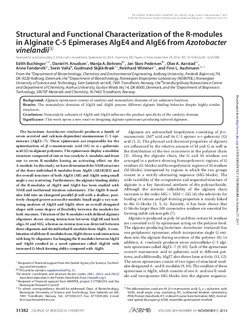| dc.contributor.author | Buchinger, Edith | |
| dc.contributor.author | Knudsen, Daniel H. | |
| dc.contributor.author | Behrens, Manja A. | |
| dc.contributor.author | Pedersen, Jan Skov | |
| dc.contributor.author | Aarstad, Olav Andreas | |
| dc.contributor.author | Tøndervik, Anne | |
| dc.contributor.author | Valla, Svein | |
| dc.contributor.author | Skjåk-Bræk, Gudmund | |
| dc.contributor.author | Wimmer, Reinhard | |
| dc.contributor.author | Aachmann, Finn Lillelund | |
| dc.date.accessioned | 2017-10-30T10:22:57Z | |
| dc.date.available | 2017-10-30T10:22:57Z | |
| dc.date.created | 2014-12-01T10:59:56Z | |
| dc.date.issued | 2014 | |
| dc.identifier.citation | Journal of Biological Chemistry. 2014, 289 (45), 31382-31396. | nb_NO |
| dc.identifier.issn | 0021-9258 | |
| dc.identifier.uri | http://hdl.handle.net/11250/2462798 | |
| dc.description.abstract | The bacterium Azotobacter vinelandii produces a family of seven secreted and calcium-dependent mannuronan C-5 epimerases (AlgE1–7). These epimerases are responsible for the epimerization of β-d-mannuronic acid (M) to α-l-guluronic acid (G) in alginate polymers. The epimerases display a modular structure composed of one or two catalytic A-modules and from one to seven R-modules having an activating effect on the A-module. In this study, we have determined the NMR structure of the three individual R-modules from AlgE6 (AR1R2R3) and the overall structure of both AlgE4 (AR) and AlgE6 using small angle x-ray scattering. Furthermore, the alginate binding ability of the R-modules of AlgE4 and AlgE6 has been studied with NMR and isothermal titration calorimetry. The AlgE6 R-modules fold into an elongated parallel β-roll with a shallow, positively charged groove across the module. Small angle x-ray scattering analyses of AlgE4 and AlgE6 show an overall elongated shape with some degree of flexibility between the modules for both enzymes. Titration of the R-modules with defined alginate oligomers shows strong interaction between AlgE4R and both oligo-M and MG, whereas no interaction was detected between these oligomers and the individual R-modules from AlgE6. A combination of all three R-modules from AlgE6 shows weak interaction with long M-oligomers. Exchanging the R-modules between AlgE4 and AlgE6 resulted in a novel epimerase called AlgE64 with increased G-block forming ability compared with AlgE6. | nb_NO |
| dc.language.iso | eng | nb_NO |
| dc.publisher | American Society for Biochemistry and Molecular Biology | nb_NO |
| dc.title | Structural and functional characterization of the R-modules in alginate C-5 epimerases AlgE4 and AlgE6 from Azotobacter vinelandii | nb_NO |
| dc.type | Journal article | nb_NO |
| dc.type | Peer reviewed | nb_NO |
| dc.description.version | publishedVersion | nb_NO |
| dc.source.pagenumber | 31382-31396 | nb_NO |
| dc.source.volume | 289 | nb_NO |
| dc.source.journal | Journal of Biological Chemistry | nb_NO |
| dc.source.issue | 45 | nb_NO |
| dc.identifier.doi | 10.1074/jbc.M114.567008 | |
| dc.identifier.cristin | 1179102 | |
| dc.relation.project | Norges forskningsråd: 221576 | nb_NO |
| dc.description.localcode | This research was originally published in Journal of Biological Chemistry, September 29, 2014 by The American Society for Biochemistry and Molecular Biology, Inc. | nb_NO |
| cristin.unitcode | 194,66,15,0 | |
| cristin.unitname | Institutt for bioteknologi og matvitenskap | |
| cristin.ispublished | true | |
| cristin.fulltext | original | |
| cristin.qualitycode | 2 | |
